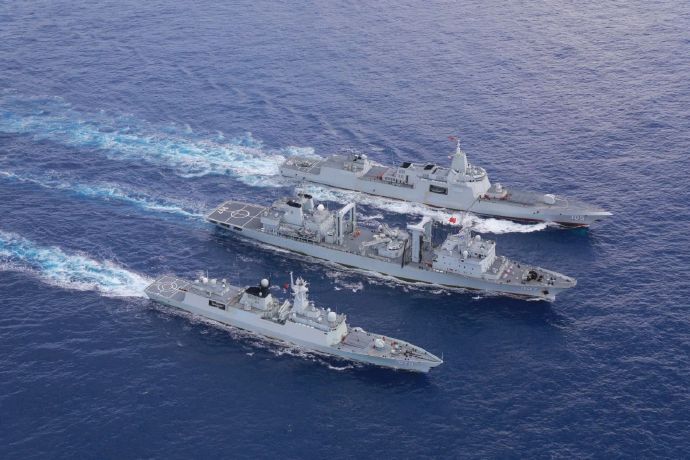Over the past decade, China has made astounding strides in building one of the world’s most formidable naval forces. The recent live-fire exercises in the South Pacific, which included the 055-class missile destroyer Zunyi, the 903-class supply ship Weishanhu, and the 054A-class frigate Hengyang, have shocked Western media and military analysts. With its cutting-edge destroyers, expanding amphibious fleet, and dominance in frigates, China has clearly established itself as a naval powerhouse. Let’s dive into how China’s naval strength has evolved, and why it has the West on edge.
1. Destroyers: From Playing Catch-Up to Running Ahead
- China (2015): In 2015, China had only a small number of 052C/D-class destroyers.
- China (2025): By 2025, China will have over 53 destroyers, including 8 055-class (10,000-ton) and 28 052D/DL-class destroyers. This brings the total to 42 Chinese-Aegis-equipped warships, with an additional 11 from older models and Russian imports. That’s over 56 ships and possibly even more by the end of 2025.
- The 055-class destroyer is equipped with 112 vertical launch units and advanced multi-band radar, making it one of the world’s most powerful destroyers.
- With the YJ-21 anti-ship ballistic missile, it can cover core Australian cities, a range of 1,500 km.
- U.S. (2015): The U.S. had 77 destroyers, including the iconic Arleigh Burke-class.
- U.S. (2025): By 2025, the fleet will shrink to 71 destroyers. While the Arleigh Burke-class remains the backbone, the U.S. faces the challenge of retiring old ships and the slow progress of its next-gen DDG(X) program. The gap between China and the U.S. in destroyer numbers and capability may continue to narrow in the coming years.
China’s destroyers not only outnumber the U.S.’s but also pack advanced technology, positioning China’s navy to support long-range operations, including aircraft carrier task forces. Moreover, there are rumors that China is designing an even larger destroyer.
2. Amphibious Assault Ships: From Zero to Global Leader
- China (2015): In 2015, China had no amphibious assault ships.
- China (2025): By 2025, China will possess 4 075-class (40,000-ton) ships and 1 076-class (50,000-ton) ship with electromagnetic catapults. This technology has garnered attention from U.S. media, which even referred to the 076-class as a “medium-sized aircraft carrier.” Production is rapidly increasing.
- U.S. (2015): The U.S. maintained 9 amphibious assault ships, including the Wasp and America classes.
- U.S. (2025): Construction of U.S. amphibious ships has slowed down, and one ship was lost due to a fire. The U.S. still has 9 ships, but China’s growing fleet is quickly catching up.
China’s amphibious assault ships are a game-changer, bolstering its capabilities in island warfare and overseas operations. The 076’s electromagnetic catapults can launch both fixed-wing aircraft and helicopters, strengthening China’s long-range naval capabilities. Future deployments, including in the South Pacific, will likely feature this innovative ship.
3. Frigates: China’s Dominance in Numbers and Anti-Submarine Warfare
- China (2015): The Chinese navy’s frigate fleet includes:
- 2 054-class
- 43 054A-class
- 2 054B-class
- 8 053H3-class
- 50 056A-class
- Total: 105 frigates, even with many retired vessels now serving in the Coast Guard.
These ships play a critical role in protecting larger vessels, patrolling, and training future naval officers. The large number of frigates in service allows China to rapidly develop its naval leadership and support its destroyers and aircraft carriers.
- U.S. (2015): The U.S. had 52 smaller surface combatants.
- U.S. (2024): The number of U.S. frigates is now down to 22, as frigates have been replaced by littoral combat ships, which have been criticized for their lack of practicality.
China’s frigates, with their high cost-efficiency and rapid production rates, provide a substantial advantage in long-range escort missions and regional defense. With China outpacing the U.S. in frigate numbers, it is well on track to lead the world in frigate dominance.
4. Aircraft Carriers: From Refitting to Innovation
- China (2015): In 2015, China had just one carrier, the Liaoning—a refit of a Soviet vessel.
- China (2025): In 2025, China has three carriers, including the Fujian, which features electromagnetic catapults and a displacement of over 80,000 tons. Additionally, a nuclear-powered 004-class carrier could join the fleet by 2030.
- U.S. (2015): The U.S. had 12 aircraft carriers.
- U.S. (2025): In 2025, the U.S. has 11 carriers, and with the high maintenance costs, this number may decrease to 9 by 2030.
China’s leap in carrier technology is remarkable. The Fujian will likely be the first to surpass U.S. technology with its electromagnetic catapults, a clear indication that China is catching up fast in naval aviation. The addition of nuclear-powered carriers will further enhance China’s global maritime presence.
5. Supporting Vessels: Supply and Landing Ships
China’s naval expansion isn’t limited to destroyers, frigates, and carriers. The country has also rapidly built up its fleet of supply ships and amphibious landing vessels. With shipbuilding capacity at the forefront globally, China is launching 25 warships per year on average, far surpassing the U.S.’s pace.
While the U.S. struggles with budget constraints and aging vessels, China has leapfrogged in key areas like electromagnetic catapults and hypersonic missiles, while the U.S. relies on its traditional strengths, which are increasingly outdated.
A Decade of Transformation: From “Yellow-Water” to “Blue-Water”
China’s navy has undergone a stunning transformation in just ten years, evolving from a “yellow-water” (nearshore) navy to a “blue-water” (ocean-going) force. The speed at which China has developed its fleet has left the world astounded. With new assets like the nuclear-powered carriers and the innovative 076-class amphibious ships joining the fleet, China’s naval capabilities in the Western Pacific will surpass those of the U.S. and even the U.S.-Japan-South Korea alliance.
As China continues to expand and modernize its fleet, it is poised to play a crucial role in maintaining global maritime peace in the years to come. Whether in the South Pacific or beyond, China’s navy will establish itself as a dominant force to be reckoned with.
